Starting Your Low-Maintenance Patio Journey****
Hey, if you’re a busy plant lover, creating a stunning outdoor patio doesn’t have to be a chore. You can design a space that thrives with minimal effort by choosing smart, easy-care options. Think drought-tolerant plants like succulents, which need watering only every 2-3 weeks, or potted setups for quick rearranging. Want to know the top 10 ideas to transform your space? Stick around for practical tips!
Contents
- 1 Opt for Drought-Tolerant Plants
- 2 Incorporate Succulents for Easy Care
- 3 Use Potted Plants for Flexibility
- 4 Install Artificial Turf for a Green Look
- 5 Choose Perennials for Year-Round Beauty
- 6 Add Gravel or Mulch to Reduce Weeding
- 7 Design With Hardscaping Elements
- 8 Select Self-Watering Planters
- 9 Focus on Native Plant Varieties
- 10 Create Shade With Low-Care Vines
Opt for Drought-Tolerant Plants
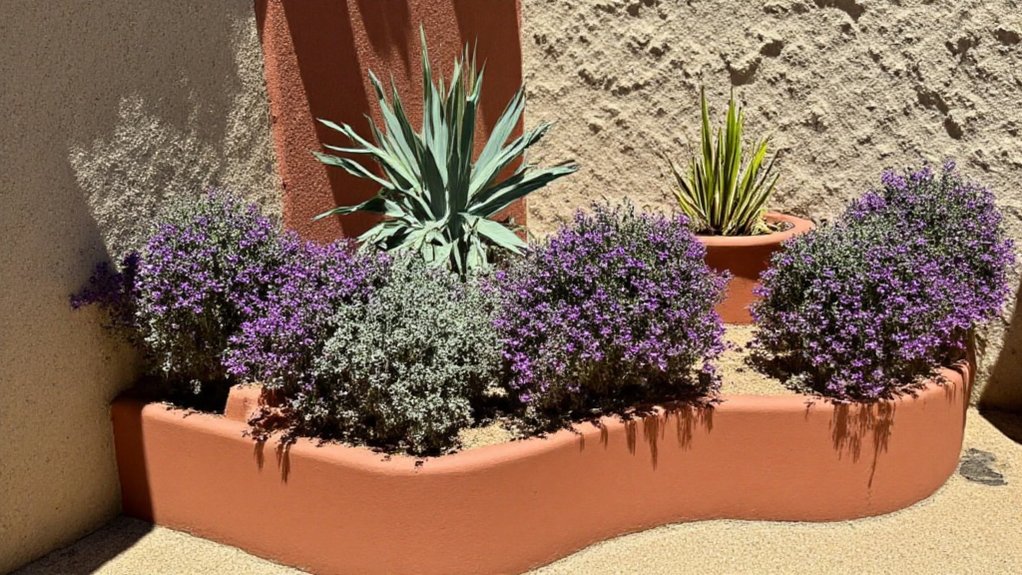
Choosing drought-tolerant plants is a smart strategy for creating a low-maintenance outdoor patio. These plants, often referred to as xeriscape plants, are adapted to thrive in dry conditions with minimal watering, making them ideal for busy homeowners or those in arid climates. Examples include succulents like aloe and agave, as well as hardy perennials such as lavender and yarrow, which not only conserve water but also add texture and color to your patio space.
Incorporate Succulents for Easy Care
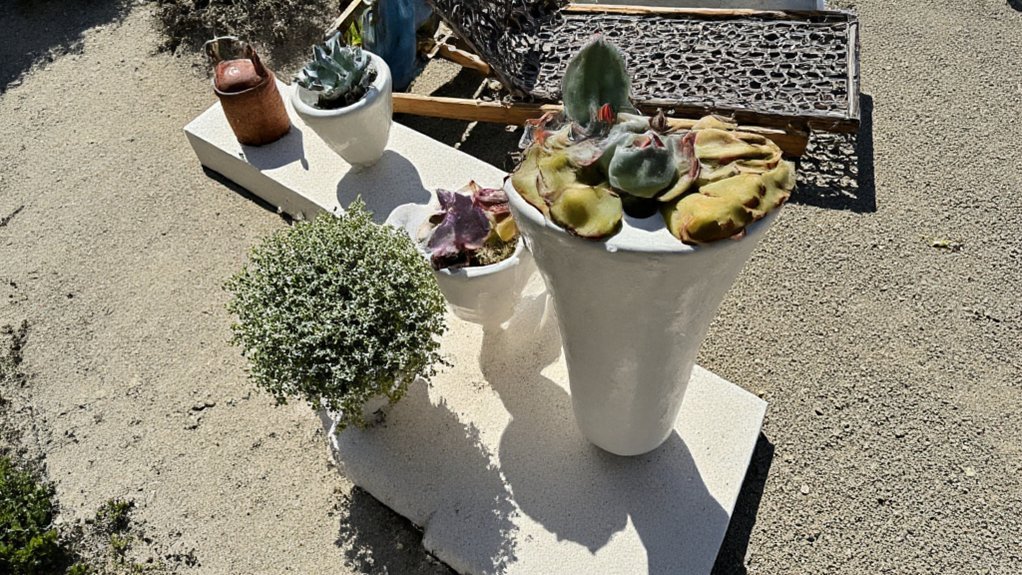
Incorporating succulents into your outdoor patio design is a fantastic way to achieve a low-maintenance yet visually appealing space. Succulents are hardy plants that thrive in a variety of conditions, requiring minimal watering and care due to their ability to store water in their leaves. This makes them ideal for busy homeowners or those looking to reduce garden upkeep while still enjoying a touch of greenery.
You can plant succulents in pots, hanging planters, or directly in the ground as part of a rock garden on your patio. Their diverse shapes, sizes, and colors add texture and interest to the space, and they pair beautifully with other drought-tolerant plants or decorative stones. With just a little sunlight and occasional watering, succulents can transform your patio into a stylish, hassle-free oasis.
Use Potted Plants for Flexibility
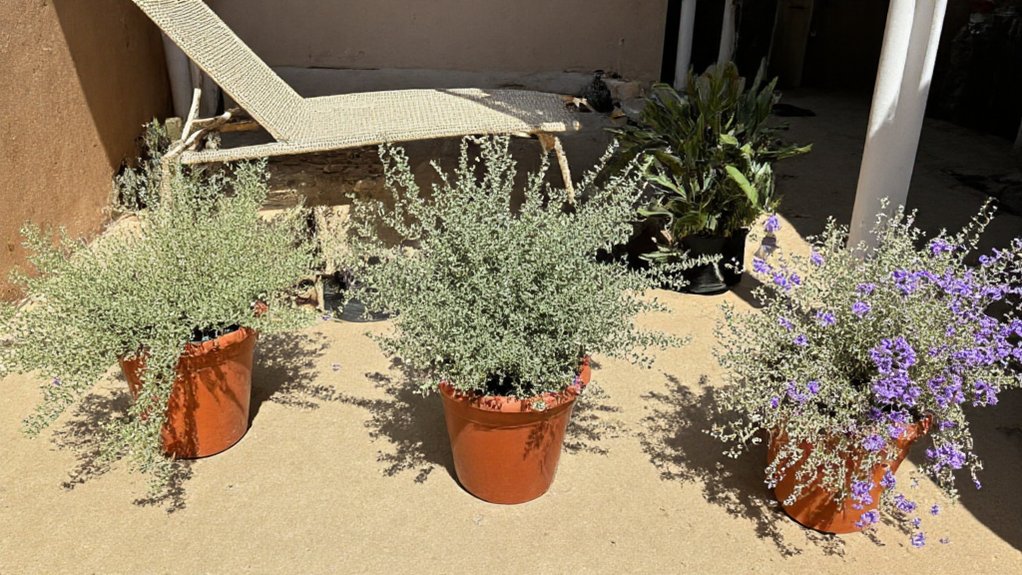
Potted plants are an excellent choice for adding greenery to your outdoor patio while maintaining flexibility and ease of care. They allow you to experiment with different plant types, colors, and arrangements without committing to permanent landscaping. You can easily move pots around to create new looks, adjust for sunlight needs, or bring them indoors during harsh weather, making them ideal for low-maintenance outdoor spaces.
Additionally, potted plants require less upkeep than in-ground gardens since they reduce the need for weeding and extensive soil preparation. Opt for drought-resistant or hardy plants like succulents, herbs, or small shrubs to minimize watering and care. Grouping pots of varying sizes and heights can also create visual interest, transforming your patio into a lush, inviting area with minimal effort.
Install Artificial Turf for a Green Look
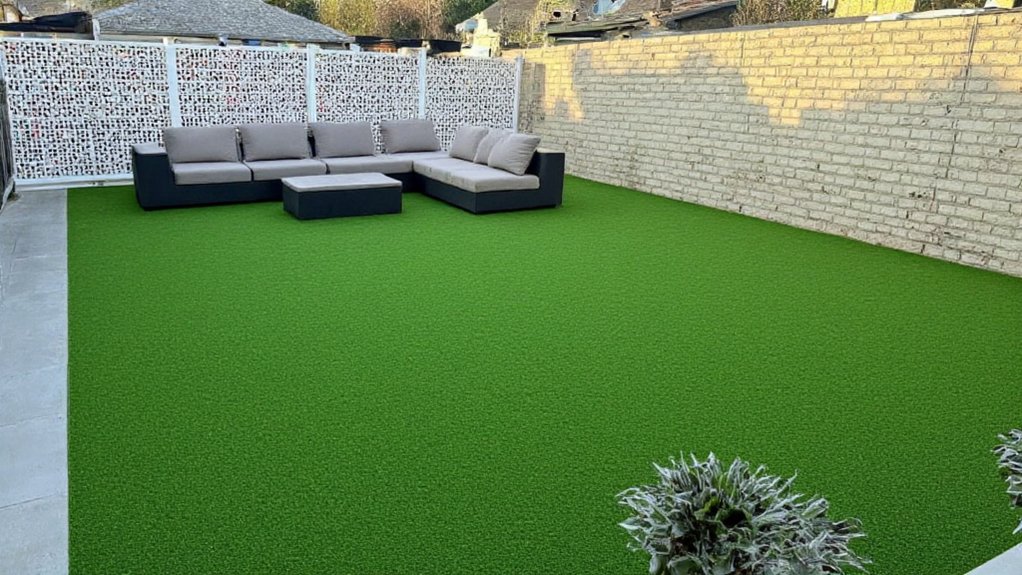
Installing artificial turf is an excellent low-maintenance option for achieving a lush, green look on your outdoor patio without the hassle of natural grass. Unlike real grass, artificial turf requires no mowing, watering, or fertilizing, making it a time-saving and cost-effective solution for busy homeowners. It’s designed to withstand various weather conditions, ensuring your patio remains vibrant year-round.
Additionally, artificial turf is durable and resistant to wear and tear, making it ideal for high-traffic areas or spaces where children and pets play. With a variety of styles and shades available, you can choose a turf that mimics the appearance of natural grass while enjoying the benefits of minimal upkeep. Simply sweep or rinse it occasionally to keep it clean, and your patio will maintain its fresh, green aesthetic effortlessly.
Choose Perennials for Year-Round Beauty
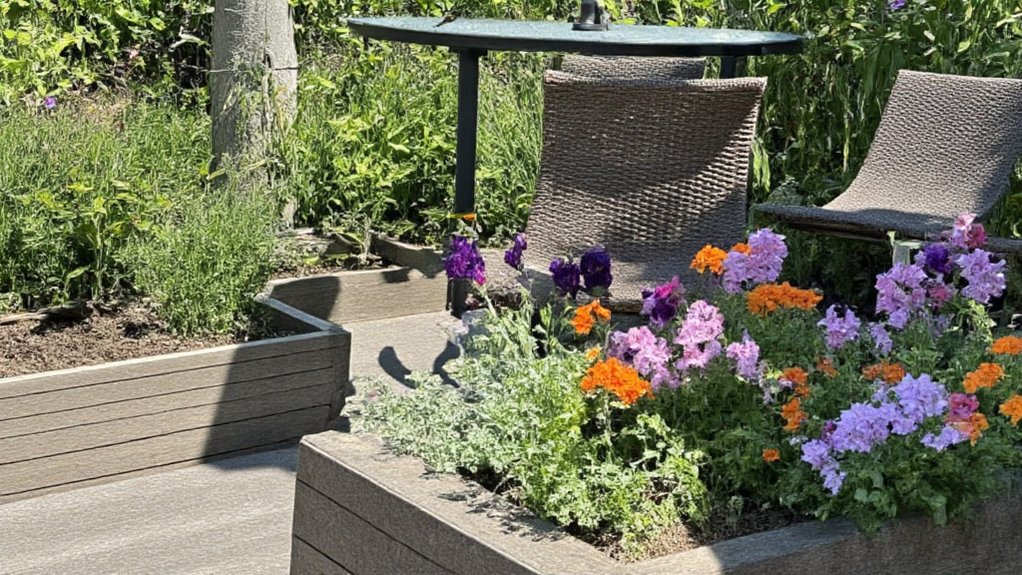
Opting for perennials in your outdoor patio design is a smart choice for achieving year-round beauty with minimal upkeep. Perennials are plants that return each year, eliminating the need for replanting and offering a reliable display of color and texture through the seasons. By selecting a variety of perennials that bloom at different times, you can guarantee your patio area remains vibrant from spring through fall, with some even providing winter interest through evergreen foliage or seed heads.
When choosing perennials, consider native species or those well-suited to your local climate, as they tend to require less water and care while thriving in their natural environment. Popular low-maintenance options include lavender, coneflowers, and daylilies, which not only add aesthetic appeal but also attract pollinators like bees and butterflies, enhancing the ecological value of your patio space.
Add Gravel or Mulch to Reduce Weeding

Adding gravel or mulch to your outdoor patio area is an effective way to reduce the need for frequent weeding. These materials act as a barrier, preventing weed seeds from reaching the soil and germinating. Gravel, in particular, provides a clean, modern look and is highly durable, while mulch offers a natural aesthetic and can help retain soil moisture.
To implement this low-maintenance solution, lay down a weed barrier fabric before spreading a thick layer of gravel or mulch over the desired areas. This extra step guarantees even greater protection against weeds, minimizing upkeep and allowing you to enjoy your patio space with less effort.
Design With Hardscaping Elements

Hardscaping elements are a fantastic way to create a low-maintenance outdoor patio that remains visually appealing and functional. These non-living components, such as pavers, stone, concrete, or gravel, form the foundation of your patio design and reduce the need for constant upkeep compared to grassy or plant-heavy spaces. By incorporating hardscaping, you can define seating areas, walkways, or even built-in features like fire pits and retaining walls, all while minimizing the time spent on mowing, watering, or weeding.
When designing with hardscaping, consider materials that suit your climate and aesthetic preferences, such as durable concrete for a modern look or natural stone for a rustic feel. Adding texture and variety through different shapes, sizes, or patterns can elevate the design without increasing maintenance demands. Additionally, hardscaping can be paired with minimal greenery, like potted plants or drought-resistant landscaping, to soften the look while keeping care requirements low.
Select Self-Watering Planters
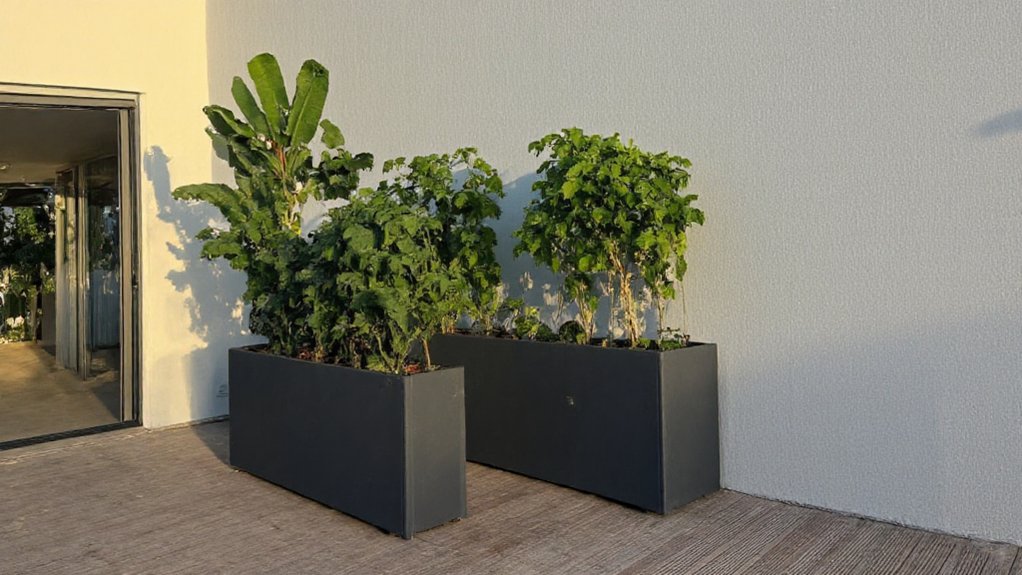
Self-watering planters are an excellent choice for a low-maintenance outdoor patio, as they reduce the need for frequent watering and help guarantee plants thrive with minimal effort. These planters are designed with a built-in reservoir that holds water, allowing plants to draw moisture as needed through a wicking system or capillary action. This feature is especially beneficial for busy homeowners or those who may forget to water regularly, as it keeps plants hydrated for extended periods, even during hot or dry weather.
When selecting self-watering planters, consider the size and material to match your patio’s aesthetic and the needs of your plants. Opt for durable materials like resin or ceramic that can withstand outdoor conditions, and guarantee the planter size accommodates the root systems of your chosen greenery. Available in various styles and colors, self-watering planters can seamlessly blend into your patio design while providing a practical solution for effortless plant care.
Focus on Native Plant Varieties
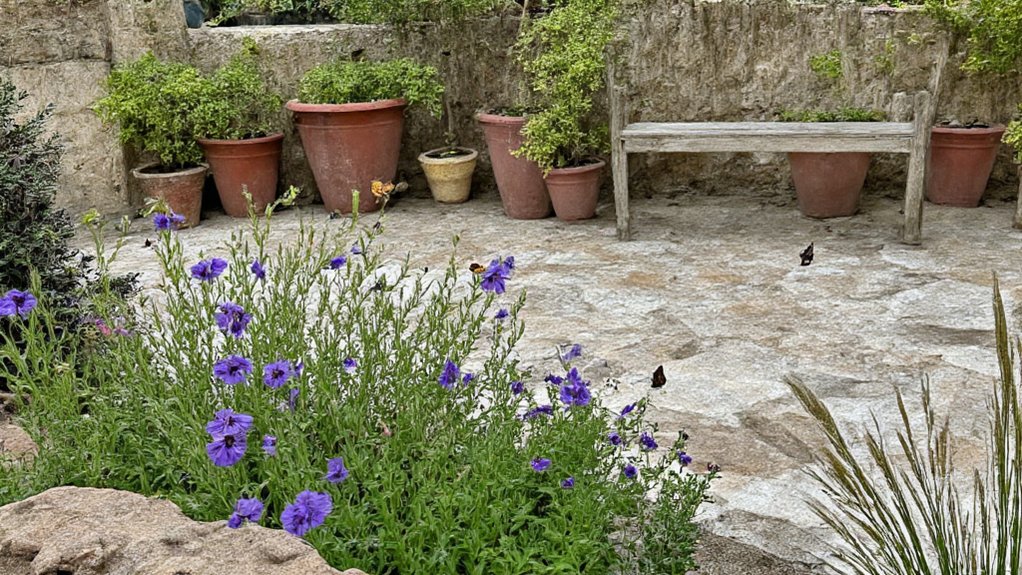
Incorporating native plant varieties into your outdoor patio design is a smart choice for low-maintenance landscaping. Native plants are naturally adapted to the local climate, soil conditions, and rainfall patterns, which means they require less watering, fertilizing, and pest control compared to non-native species. By choosing plants that thrive in your region, you can create a beautiful patio space that blends seamlessly with the surrounding environment while minimizing upkeep.
Additionally, native plants often support local ecosystems by providing food and habitat for pollinators like bees, butterflies, and birds. This not only enhances the biodiversity of your patio area but also contributes to a healthier environment. To get started, research plants indigenous to your area through local nurseries or extension services, and select a mix of perennials, shrubs, and ground covers that suit your patio’s aesthetic and sunlight conditions.
Create Shade With Low-Care Vines
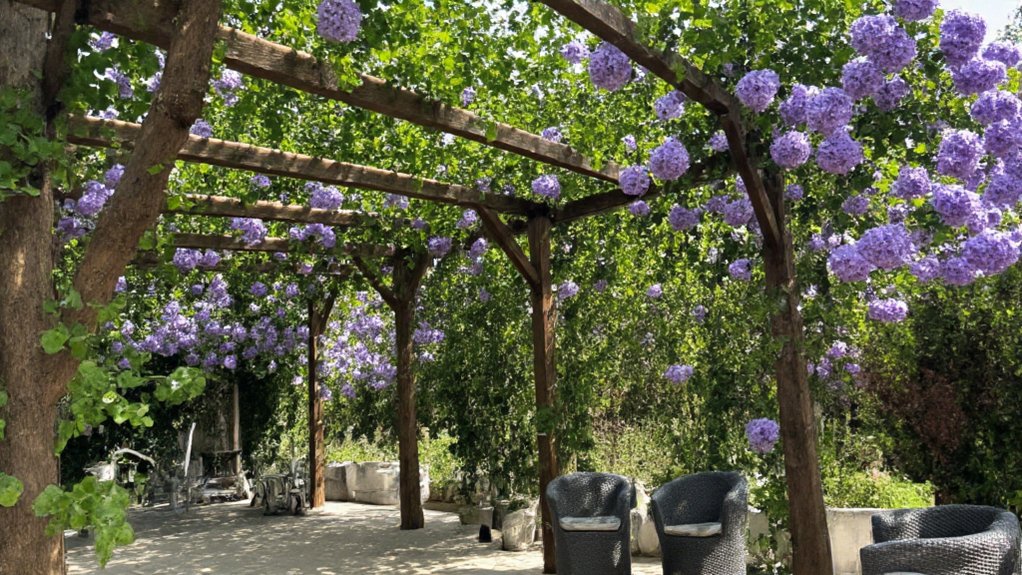
Creating shade with low-care vines is an excellent way to enhance your outdoor patio while keeping maintenance to a minimum. Vines like clematis, honeysuckle, or climbing hydrangea can be trained to grow over trellises, pergolas, or arbors, providing natural shade and a lush, green aesthetic. These plants are often hardy and require little more than occasional pruning and watering once established, making them ideal for busy homeowners.
To implement this idea, choose a vine suited to your climate and patio conditions, ensuring it gets the right amount of sunlight and has a sturdy structure to climb. Planting near a support system and using well-draining soil will help the vine thrive with minimal effort. As a bonus, many low-care vines attract pollinators like bees and butterflies, adding life and color to your outdoor space.
